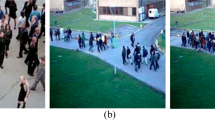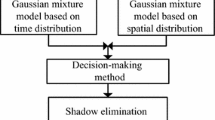Abstract
People gather together for myriad reasons and in an overcrowded region, human detection is a very challenging problem. Automated multiple human detection is one of the most active research fields of computer vision applications. It provides useful information for crowd monitoring and traffic controlling for human safety in public places. The conventional Gaussian mixture model, that has a fixed K values, is not enough for dynamically varying background and further foreground detection is a time consuming process. The automated multiple human detection algorithms are needed to deal with complex background and illumination change conditions of crowd scene. In this paper, an automated multiple human detection method using hybrid adaptive Gaussian mixture model is proposed to handle efficiently the complex background and illumination changes. The proposed hybrid algorithm utilizes spatiotemporal features, adaptive learning control, adaptively changing weights and an adaptive selection with number of K Gaussian components per pixel to withstand in complex background and different lighting conditions. The experimental results and performance measures demonstrate that the proposed hybrid method performs well for crowd scene. By using the proposed adaptive hybrid method, the multiple human detection rate has been improved from 90 % to 95 % and the computational time is reduced from 5s e c s to 2.5s e c s.








Similar content being viewed by others
References
Bouwmans T (2014) Traditional and Recent approaches in Background Modeling for Foreground Detection: An Overview. Comput Sci Rev 11:31–66
Bouwmans T, El Baf F, Vachon B (2008) Background Modelling using Mixture of Gaussians for Foreground Detection: A Survey. Recent Patents Comput Sci 1(3):219–237
Eshel R, Moses Y (2008) Homography based multiple-camera detection and tracking of people in a dense crowd. In: Proceedings of the conference on computer vision and pattern recognition
Fazli S, Pour HM, Bouzari H (2009) A Novel GMM-Based Motion Segmentation Method for Complex Background. The 5th IEEE-GCC Conference
Ferryman J, Ellis AL (2014) Performance evaluation of crowd image analysis using the PET 2009 dataset. Pattern Recognit Lett 44:3–15
Hu Z et al (2011) Selective Eigenbackgrounds method for background subtraction in crowd scenes. IEEE International Conference on image processing, pp 3277–3280
Karpagavalli P, Ramprasad AV (2013) Estimating of the density of people and counting the number of people in crowded environment for human safety. In: IEEE international conference on communications and signal processing (ICCSP), pp 663–667
Karpagavalli P, Ramprasad AV (2013) Human detection and segmentation in the crowd environment by combining APD with HLBD approaches. In: National conference on computer vision, pattern recognition, image processing and graphics (NCVPRIPG), pp 1–4
Kentaro T, Krumm J, Brumitt B, Meyers B (1999) Principles and practice of background maintenance. In: Proceedings of the Seventh IEEE international conference on computer vision (ICCV99), 1:255261
Kertesz C (2011) Texture-based foreground detection. Int J Signal Process Image Process Pattern Recognit 4:51–61
Kim Z (2008) Real time object tracking based on dynamic feature grouping with background subtraction. In: Proceedings of IEEE conference on computer vision pattern recognition, pp 1–8 (2008)
Kim K et al (2005) Real-time foreground-background segmentation using codebook model. Real-Time Imaging 11(3):172–185
Ko T, Soatto S, Estrin D (2008) Background subtraction on distributions. In: Computer vision ECCV 2008, pp 276289. Springer
Lee DS (2005) Effective gaussian mixture learning for video background subtraction. IEEE Trans Pattern Anal Mach, Intell 27(5):827–832
Li HH, Chuang JH, Liu TL (2011) Regularized background adaptation: A novel learning rate control scheme for gaussian mixture modeling. IEEE Trans Image Process 3(20):822–836
Mahadevan V, Vasconcelos N (2008) BGS in highly dynamic scenes. In: IEEE conference on computer vision and pattern recognition, pp 1–6
Richard J, Radke S, AI-Kofahi O, Roysam B (2005) Image change detection algorithms: a systematic survey. IEEE Trans Image Process 4(3):294–307
Stauffer C, Grimson WEL (2000) Learning patterns of activity using real-time tracking. IEEE Trans Pattern Analysis and Mach Intell 22(8):747–757
Sobral A, Vacavant A (2014) A comprehensive review of background subtraction algorithms evaluated with synthetic and real videos. Comput Vis Image Underst 122:4–21
Suo P, Wang Y (2008) An Improved Adaptive Background Modeling Algorithm Based on Gaussian Mixture Model. In: IEEE Proceedings of ICSP 2008
Sun L, Sheng W, Liu Y (2015) Background modeling and its evaluation for complex scenes. Multimedia Tools Appl 74:3947–3966
Tan R, Huo H, Qian J, Fang T (2006) Traffic video segmentation using adaptive-K Gaussian mixture model. In: The international workshop on intelligent computing (IWICPAS 2006), pp 125–134
Tian Y, Wang Y, Hu Z, Huang T (2013) Selective Eigenbackground for background modeling and subtraction in crowded scenes. In: IEEE transactions on circuits and systems for video technology
Van Droogenbroeck M, Paquot O (2012) Background Subtraction: Experiments and Improvements for ViBe, Change Detection Workshop (CDW)
Wang H, Suter D (2006) A novel robust statistical method for background initialization and visual surveillance. In: Computer vision ACCV 2006, pp 328337. Springer
Wu B, Nevatia R (2005) Detection of multiple, partially occluded humans in a single image by Bayesian combination of edgelet part detectors. In: Proceedings IEEE international conference on computer vision, vol 1, pp 90–97
Yao L, Ling M (2014) An improved mixture-of-Gaussians background model with frame difference and blob tracking in video stream. Sci World J 424050
Zhao L, Davis LS (2005) Closely coupled object detection and segmentation. In: Proceedings IEEE international conference on computer vision, pp 454–461
Zivkovic Z (2004) Improved adaptive Gaussian mixture model for background subtraction. In: Proceeding ICPR, 2004
Acknowledgments
Research and computing facilities was provided by the K.L.N. College of Engineering, Tamil Nadu, India.
Author information
Authors and Affiliations
Corresponding author
Rights and permissions
About this article
Cite this article
Karpagavalli P., Ramprasad A. V. An adaptive hybrid GMM for multiple human detection in crowd scenario. Multimed Tools Appl 76, 14129–14149 (2017). https://doi.org/10.1007/s11042-016-3777-4
Received:
Revised:
Accepted:
Published:
Issue Date:
DOI: https://doi.org/10.1007/s11042-016-3777-4




